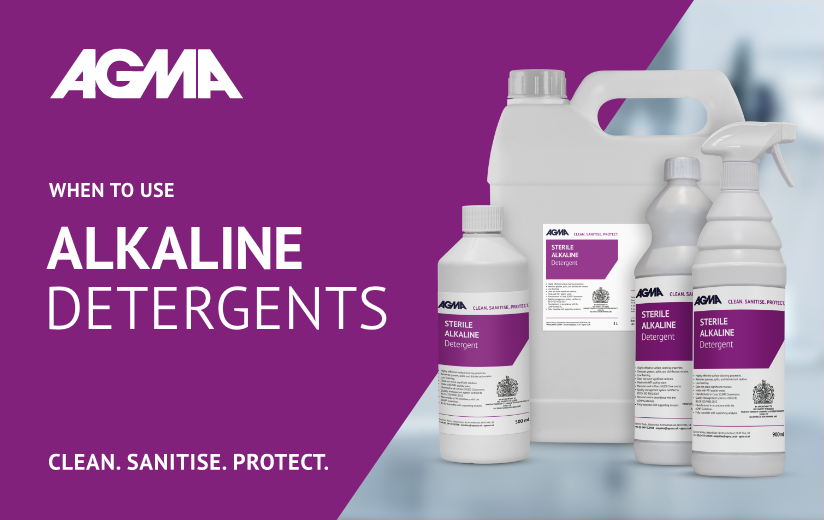In aseptic drug manufacturing cleanrooms, alkaline detergents play an important role in maintaining standards of cleanliness.
This blog will run through some instances on when and how you should use an alkaline detergent to uphold standards of cleanliness in your cleanroom.
Why alkaline detergent?
In cleanrooms, we rely on detergents to physically remove dirt, debris and residue from surfaces before disinfecting them.
The surfactant molecules in detergents have a hydrophobic tail which binds to oils and grease, and a hydrophilic head which binds to water.
Detergents work by these molecules surrounding dirt and grease (forming micelles), lifting them off surfaces, and suspending them in water so they can be rinsed away.
Detergents work even better in an alkaline pH. In alkaline conditions, fats and oils can be chemically converted into soap and glycerol, making them easier to remove. Oils are easily emulsified and suspended in water. Alkaline environments can break down organic matter more effectively, aiding in the removal of complex biological residues. Cleaning solutions can also spread more efficiently over surfaces because alkaline conditions improve the action of wetting agents. All this means that in most cleaning scenarios, alkaline detergents are more effective.
Different task, different detergent?
In pharmaceutical cleanrooms, the choice of detergent is typically guided by the nature of the contamination. Neutral detergents work well for everyday cleaning. Alkaline detergents are preferred for their effectiveness in removing organic residues and greases.
When might you use an alkaline detergent for your cleanroom?
Initial cleaning
When the cleanroom is first constructed or after any major maintenance activities, an initial cleaning with alkaline detergent can effectively remove construction residues, heavy soils, and contaminants.
Contamination or spill
If there has been a significant contamination event or a spill of substances that are not easily removed by neutral cleaners, an alkaline detergent may be necessary. Alkaline detergents are particularly effective against protein and organic residues, which are common in pharmaceutical environments. Use them when there is a known presence of these types of contaminants.
Routine cleaning
To prevent the build-up of any specific type of residue and to manage microbial contamination, it is often recommended to rotate the types of cleaning agents used, including periodic use of alkaline detergents. Even in routine operations, rotating or periodically deep cleaning with an alkaline detergent can help to ensure that any build-up of residues that neutral or acidic cleaners may not remove is effectively eliminated.
Cleaning equipment and instruments
For cleaning glassware, stainless steel surfaces, and other durable equipment, alkaline detergents can be effective in removing tough residues without damaging the materials.
Best practices for using alkaline detergents
RFU and contact time
RFU or ready for use products do not need diluting and can be used straight away. Always observe the detergent manufacturer’s instructions to achieve optimal cleaning without damaging surfaces.
Thorough rinsing
Always rinse thoroughly with High Purity Water after using alkaline detergents to prevent any residue that might interfere with aseptic conditions.
Safety measures
Use appropriate personal protective equipment (PPE) when handling alkaline detergents to protect against chemical exposure.
Environmental monitoring
After cleaning with alkaline detergents, conduct environmental monitoring to ensure that the cleaning process has effectively removed contaminants and that there is no residual detergent.
Regular reviews
Periodically review and update cleaning protocols based on new findings, contamination events, or changes in the manufacturing process.
Manufacturer recommendations
Always follow the standard operating procedures specific to your cleanroom and the recommendations of the detergent manufacturers. These procedures will be based on validation studies that demonstrate the effectiveness and compatibility of the detergents with the cleanroom materials and processes. Simply put, if you don’t use a product according to these recommendations, you can’t know if it will work.
By following these guidelines, you can effectively incorporate alkaline detergents into your cleanroom cleaning regimen, ensuring that aseptic conditions are maintained to the highest standards.
Introducing AGMA Sterile Alkaline Detergent
We developed Sterile Alkaline Detergent for intensive cleaning tasks to help cleanroom operators meet the standards of Annex 1.
Sterile Alkaline Detergent effectively removes stubborn contaminants, minimising particulate generation, and enhancing microbial control. While ideal for tough cleaning challenges, it complements our sterile neutral detergent for delicate surfaces, allowing operators to maintain the highest standards of cleanliness and safety by tailoring their cleaning protocols to specific cleanroom needs.
Designed for cleaning various surfaces in cleanroom environments, AGMA Sterile Alkaline Detergent is gamma-irradiated for sterility and features a double-bagged system to ensure in-use sterility. Manufactured to GMP standards with full traceability and supporting documentation, making contamination control straightforward and reliable. Find out more. >


